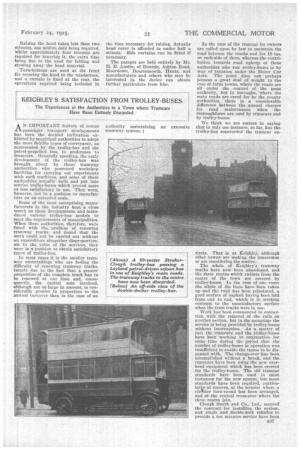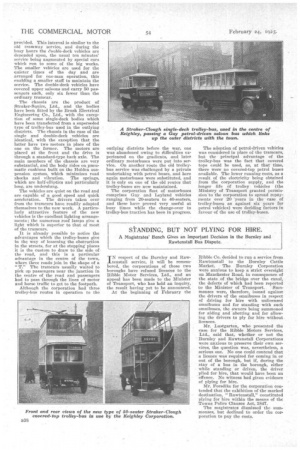KEIGHLEY'S SATISFACTION FROM TROLLEY-BUSES.
Page 21

Page 22

If you've noticed an error in this article please click here to report it so we can fix it.
The Experiences of the Authorities in a Town where Tramcars Have Been Entirely Discarded.
-CIA N IMPORTANT feature of recent Passenger transport developments has been the decided inclination exhibited by municipal authorities to adopt the more flexible types of conveyance, as represented. by the trolley-bus and the petrol-propelled bus, in preference to tramcars. Generally speaking, the early development of the trolley-bus was brought about by those tramway anthorities who possessed workshop facilities for carrying out experiments with such machines, and some of these authorities actually built and put into service trolley-buses which proved more or less satisfactory in use. They were, however, not in a position to manufacture on an extended scale.
Some of the most enterprising manufacturers in the industry kept a close watch on these developments and introduced various trelley-bus models to meet the requirements of municipalities. When these authorities, therefore, were faced with the, problem of renewing tramway tracks, and found that the work could not be carried out without. an expenditure altogether disproportionate to the value of the services, they were in a position to obtain satisfactory types of trolley-bus.
In most cases it is the smaller tramWay undertakings who are feeling the difficulty of renewing tramway tracks, largely due to the fact that a greater proportion of the complete track has to be renewed at one time and, consequently, the capital sum involved, although not so large in amount, is considerably greater in proportion to the annual turnover than in the case of an authority maintaining an extensive tramway system. tirely. That is at Keighley, although other towns are making the conversion or are considering the matter.
The whole of Keighley's tramway tracks have now been abandoned, and the three routes which radiate from the centre of the town are covered by trolley-buses. In the case of one route the whole of the lines have been taken up and the road has been reinstated, a good surface of asphalt having been laid from end to end, which is in striking contrast to the unsatisfactory surface when the tram tracks were in use.
Work has been commenced in connection with the removal of the rails on another section, but in the meantime the service is being provided by trolley-buses without interruption. As a matter of fact the tramcars and the trolley-buses have been working in conjunction for some time during the period that the number of trolley-buses in operation was insufficient to enable the trams to be dispensed with The change-over has been accomplished without a break, and the tramcars have been using the new overhead equipment which has been erected for the trolley-buses. The old tramcar standards have been used in most instances for the new system, but more standards have been required,particulaiVi, at corners, at the termini where a cirt. ilar turn-round has been arranged, and at the central cross-over where the three routes join.
Clough Smith and Co., Ltd., secured the contract ' for installing the system, and single and double-deck vehicles to provide a ten minutes service have been
provided. This interval is similar to the uid trantway service, and during the busy hours the d.ouble-deck vehicles are depended upon, the usual ten minutes' service being augmented by special cars which run to some of the big works. The smaller vehicles are used for the quieter times of the day and are arranged for. One-man operation, this enabling a smaller staff to maintain the service. The double-deck vehicles have covered upper saloons and carry 50 passengers each, only six fewer than the ordinary tramcar.
The chassis are the product of Straker-Squire, Ltd., and the bodies have been fitted by the Brush Electrical Engineering Co., Ltd., with the exception of some single-deck bodies which have been transferred from a superseded type of trolley-bus used in the outlying districts. The chassis in the case of the single and double-deck vehicles are identical, with the exception that the latter have two motors in place of the one on the former. The motors are placed at the front and the drive is through a standard-type back axle. The main members of the chassis are very substantial, and the body rides on pneumatic cushions built on the Holden suspension system, which minimises road shocks and vibration. The springs, which are half-elliptics and particularly long, are underslung.
The vehicles are quiet on the road and are capable of a good speed and quick acceleration. The drivers taken over from the tramcars have readily adapted themselves to the new work. A particularly attractive feature of the new vehicles is the excellent lighting arrangements ; the numerous roof lamps give a light which is superior to that of most of the tramcars.
It is already possible to notice the advantages which the trolley-buses give in the way of lessening the obstruction in the streets, for at the stopping. places it is the custom to draw to the side ofthe road, and this is a particular advantage in the centre of the town, where three roads join in the shape of a "T." The tramcars usually waited to pick op passengers near the junction in the centre of the road and passengers had to pass through the lines of motor and horse traffic to get to the footpath.
Although the corporation had three trolley-bus routes in operation to the outlying districts before the war, one was abandoned owing to difficulties experienced on the gradients, and later ordinary motorbuses were put into service. On another route the old trolleybus service was challenged by a private undertaking with petrol buses, and here again motorbuses were substituted, and it is only on one of the old routes that trolley-buses are now maintained.
The corporation fleet of motorbuses comprises Guy and Leyland vehicles ranging from 20-seaters to 40-seaters, and these have proved very _useful at busy times while the change-over to trolley-bus traction has been in progress. The adoption of petrol-driven vehicles was considered in place of the tramcars, but the principal advantage of the trolley-bus was the fact that covered tops could be used, as, at that time, there were no covered-top petrol buses available. The lower running costs, as a result of the electricity being obtained from the corporation supply, and the longer life of trolley vehicles (the Ministry of Transport granted permission'to the corporation to spread repayments over 20 "years in the ease of trolley-buses as against six years for petrol vehicles) were deciding factors in favour of the use of trolley-buses.






























